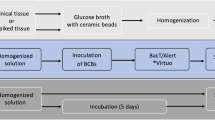Abstract
The use of blood culture systems for sterile body fluids other than blood has proven to be superior to routine culture methods. This study was conducted in order to assess the performance of the BACTEC blood culture system compared to swab/tissue sample collection for the detection of infection from intraoperative samples taken during surgical procedures. Sensitivity was determined by taking samples (BACTEC and swab/tissue samples) from patients with clinically evident infection (Infection group). Specificity was tested by taking the same sample sets from patients who had aseptic operations with no history of infection (Control group). The sensitivity was found to be much higher for the BACTEC group (50 isolates from 56 samples, sensitivity: 89%) compared to the swab/tissue samples (29 isolates out of 56 samples, sensitivity: 52%). The specificity was lower in the BACTEC group (32 isolates out of 44 samples, specificity: 27%) compared to the swab/tissue samples (1 isolate out of 44 samples, specificity: 98%). We conclude that BACTEC is useful for intraoperative sample collection in cases of low-grade infection. However, it is less specific and there is always the possibility for contamination. Therefore, it is advisable to use this technique in combination with regular tissue samples.
Similar content being viewed by others
References
Barrack RL, Harris WH (1993) The value of aspiration of the hip joint before revision total hip arthroplasty. J Bone Joint Surg Am 75(1):66–76
Lachiewicz PF, Rogers GD, Thomason HC (1996) Aspiration of the hip joint before revision total hip arthroplasty. Clinical and laboratory factors influencing attainment of a positive culture. J Bone Joint Surg Am 78(5):749–754
Levine BR, Evans BG (2001) Use of blood culture vial specimens in intraoperative detection of infection. Clin Orthop Relat Res 382:222–231
Atkins BL, Athanasou N, Deeks JJ, Crook DWM, Simpson H, Peto TEA, McLardy-Smith P, Berendt AR; Group TOCS (1998) Prospective evaluation of criteria for microbiological diagnosis of prosthetic-joint infection at revision arthroplasty. The OSIRIS Collaborative Study Group. J Clin Microbiol 36(10):2932–2939
Trampuz A, Steckelberg JM, Osmon DR, Cockerill FR, Hanssen AD, Patel R (2003) Advances in the laboratory diagnosis of prosthetic joint infection. Rev Med Microbiol 14(1):1–14
Zimmerli W, Trampuz A, Ochsner PE (2004) Prosthetic-joint infections. N Engl J Med 351(16):1645–1654
Bourbeau P, Riley J, Heiter BJ, Master R, Young C, Pierson C (1998) Use of the BacT/Alert blood culture system for culture of sterile body fluids other than blood. J Clin Microbiol 36(11):3273–3277
Elston HR, Wang M, Philip A (1990) Evaluation of isolator system and large-volume centrifugation method for culturing body fluids. J Clin Microbiol 28(1):124–125
Fuller DD, Davis TE, Kibsey PC, Rosmus L, Ayers LW, Ott M, Saubolle MA, Sewell DL (1994) Comparison of BACTEC Plus 26 and 27 media with and without fastidious organism supplement with conventional methods for culture of sterile body fluids. J Clin Microbiol 32(6):1488–1491
von Essen R, Hölttä A (1986) Improved method of isolating bacteria from joint fluids by the use of blood culture bottles. Ann Rheum Dis 45(6):454–457
Yagupsky P, Peled N, Press J (2001) Use of BACTEC 9240 blood culture system for detection of Brucella melitensis in synovial fluid. J Clin Microbiol 39(2):738–739
Belmares J, Detterline S, Pak JB, Parada JP (2007) Corynebacterium endocarditis species-specific risk factors and outcomes. BMC Infect Dis 7:4
Mookadam F, Cikes M, Baddour LM, Tleyjeh IM, Mookadam M (2006) Corynebacterium jeikeium endocarditis: a systematic overview spanning four decades. Eur J Clin Microbiol Infect Dis 25(6):349–353
Sewell DL, Coyle MB, Funke G (1995) Prosthetic valve endocarditis caused by Corynebacterium afermentans subsp. lipophilum (CDC coryneform group ANF-1). J Clin Microbiol 33(3):759–761
Achermann Y, Trampuz A, Moro F, Wüst J, Vogt M (2009) Corynebacterium bovis shoulder prosthetic joint infection: the first reported case. Diagn Microbiol Infect Dis 64(2):213–215
Lutz MF, Berthelot P, Fresard A, Cazorla C, Carricajo A, Vautrin AC, Fessy MH, Lucht F (2005) Arthroplastic and osteosynthetic infections due to Propionibacterium acnes: a retrospective study of 52 cases, 1995–2002. Eur J Clin Microbiol Infect Dis 24(11):739–744
Tleyjeh IM, Qutub MO, Bakleh M, Sohail MR, Virk A (2005) Corynebacterium jeikeium prosthetic joint infection: case report and literature review. Scand J Infect Dis 37(2):151–153
Fitzgerald RH Jr, Peterson LF, Washington JA 2nd, Van Scoy RE, Coventry MB (1973) Bacterial colonization of wounds and sepsis in total hip arthroplasty. J Bone Joint Surg Am 55(6):1242–1250
Dietz FR, Koontz FP, Found EM, Marsh JL (1991) The importance of positive bacterial cultures of specimens obtained during clean orthopaedic operations. J Bone Joint Surg Am 73(8):1200–1207
Blomgren G, Hambraeus A, Malmborg AS (1983) The influence of the total body exhaust suit on air and wound contamination in elective hip-operations. J Hosp Infect 4(3):257–268
Owers KL, James E, Bannister GC (2004) Source of bacterial shedding in laminar flow theatres. J Hosp Infect 58(3):230–232
Karpanen TJ, Conway BR, Worthington T, Hilton AC, Elliott TS, Lambert PA (2010) Enhanced chlorhexidine skin penetration with eucalyptus oil. BMC Infect Dis 10:278
Karpanen TJ, Worthington T, Conway BR, Hilton AC, Elliott TS, Lambert PA (2009) Permeation of chlorhexidine from alcoholic and aqueous solutions within excised human skin. Antimicrob Agents Chemother 53(4):1717–1719
Author information
Authors and Affiliations
Corresponding author
Rights and permissions
About this article
Cite this article
Podleska, L.E., Lendemans, S., Schmid, E. et al. Sample taking during orthopedic surgery: sensitivity and specificity using the BACTEC blood culture system. Eur J Clin Microbiol Infect Dis 31, 201–206 (2012). https://doi.org/10.1007/s10096-011-1294-y
Received:
Accepted:
Published:
Issue Date:
DOI: https://doi.org/10.1007/s10096-011-1294-y




